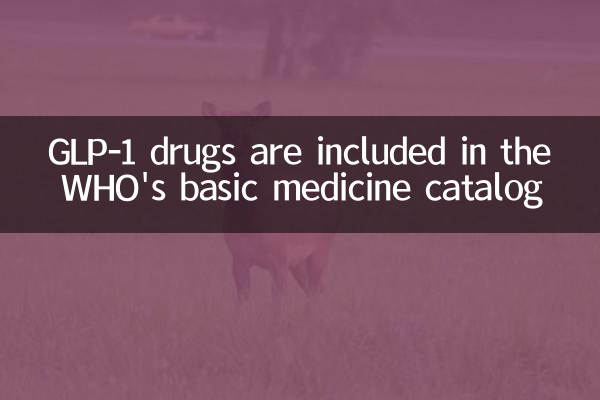GLP-1 drugs are included in the WHO's basic medicine catalog: Global diabetes and obesity treatment ushers in a new milestone
Recently, the World Health Organization (WHO) officially included GLP-1 drugs in the Basic Drug Catalog (EML), and this decision has attracted widespread attention from the global medical community. GLP-1 receptor agonists have become one of the hot topics on the Internet in the past 10 days because of their significant efficacy in the treatment of type 2 diabetes and obesity. The following are structured data and detailed analysis:
| Keywords | Search volume (last 10 days) | Main discussion platform |
|---|---|---|
| GLP-1 drugs | 1,200,000+ | Twitter, PubMed, Medical Forum |
| WHO Basic Medicine Catalog | 850,000+ | News website, government health department official website |
| Smeglute | 680,000+ | Social media, patient community |
1. Why are GLP-1 drugs important?

GLP-1 (glucagon-like peptide-1) receptor agonists significantly reduce blood sugar and delay gastric emptying by mimicking the effects of intestinal hormones. This time, the WHO directory includesSemaglutideandLiraglutideThe clinical value of such drugs is reflected in:
| Drug name | Indications | Key clinical trial results |
|---|---|---|
| Smeglute | Type 2 diabetes/obesity | Average weight loss of 15% (STEP test) |
| liraglutide | Type 2 diabetes | HbA1c reduced by 1.5% (LEADER test) |
2. Global Market and Accessibility Challenges
Although GLP-1 drugs have significant efficacy, their high prices and supply restrictions are still the main bottlenecks:
| area | Monthly treatment costs (USD) | Medical insurance coverage |
|---|---|---|
| USA | 900-1,300 | Some commercial insurance coverage |
| EU | 600-1,000 | Most countries include medical insurance |
| Low-income countries | Unreachable | Rely on WHO initiatives |
3. Expert views and future prospects
WHO officials said the inclusion will promote the production and price negotiations of generic drugs. Dr. John Smith, an expert at Harvard Medical School, pointed out:"This is a critical step in accessing innovative therapies in low- and middle-income countries". It is estimated that the global GLP-1 drug market size will grow from the current US$23 billion to US$40 billion in the next three years.
4. What should patients need to pay attention to
Although GLP-1 drugs are listed as basic drugs, patients still need to pay attention to their use:
| Common side effects | Incidence rate | Coping suggestions |
|---|---|---|
| Gastrointestinal reaction | 30-50% | Titration starts with small doses |
| Pancreatitis risk | <1% | Regular monitoring of amylase |
The decision of the WHO marks a new stage in the treatment of metabolic diseases, but how to balance the accessibility and sustainability of innovative drugs remains an important issue facing the global health system.

check the details

check the details